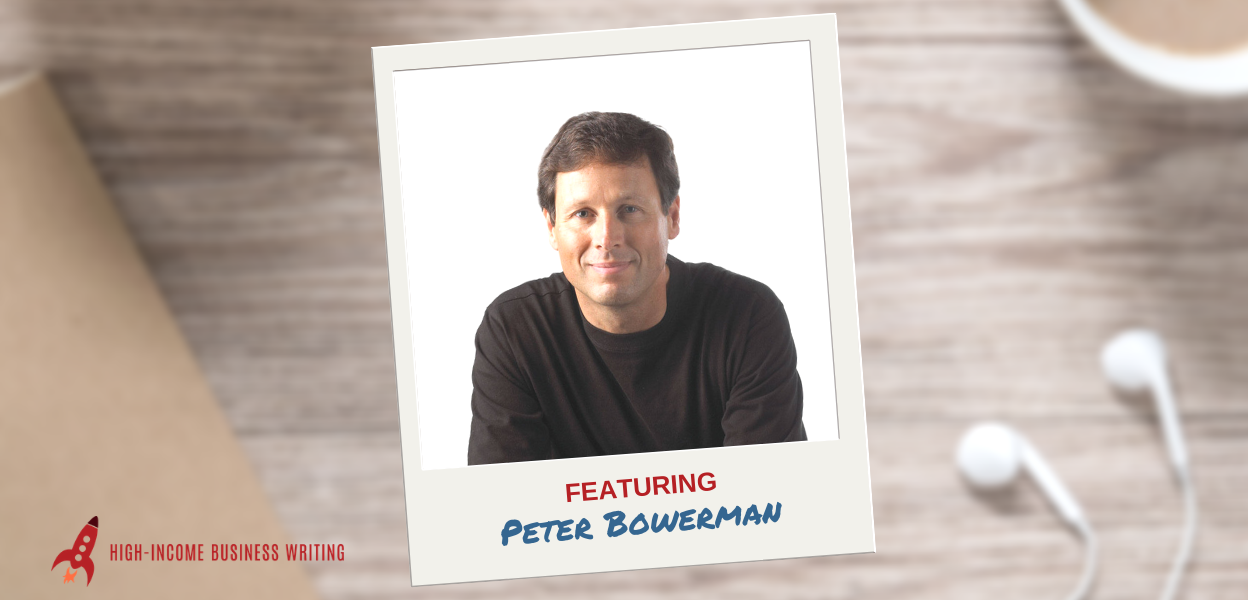Peter Bowerman — the author of The Well-Fed Writer and other “Well-Fed” books — is one of the most influential mentors in the world of commercial writing.
One of the many things Peter does very well is generating strategic partnerships with freelance designers.
Through these arrangements, Peter gets a well-paid writing gig, the designer lands work she may not have won otherwise, and the client benefits from a turnkey service solution.
In this episode, Peter reveals how this strategy has added tens of thousands of dollars to his income over the years. He explains how to contact designers … how to find them … how to structure these opportunities … how to price your work … and much more!
The notes that follow are a very basic, unedited summary of the show. There’s a lot more detail in the audio version. You can listen to the show using the audio player below. Or you can subscribe in iTunes or on Stitcher to get this show delivered straight to the Podcasts app on your smart phone, tablet or iPod.


High-Income Business Writing with Ed Gandia
#026: How (and Why) to Partner with Designers to Grow Your Business
How did partnering with designers become a key strategy in your writing business?
Chance, mostly. Peter connected with a commercial designer who went on to work for a large graphic design firm. She brought Peter in on projects.
Writer/designer partnerships are built on relationships. When you bring value to a designer, he/she will look for opportunities to bring you in on projects. They’ll lobby and advocate for you.
How do you find designers who are open to partnering?
Almost all designers are open to it. They’re hoping you’ll bring them work. The benefit of working together is that you can present a turnkey solution and handle projects from start to finish.
The key to developing these writer/designer partnerships is to have the writing skills and the persistence to stay in touch and build that relationship.
Established designers might already have writers they work with. So you may have to wait and persist. It’s easier to develop relationships with new designers, but you don’t know how long they’ll be in business.
What’s the best way to approach them?
Peter makes cold calls. If you’re relaxed and don’t sound desperate for work, you’ll have more success.
If you’re really uncomfortable with the phone, then you can use email. But these relationships are built on personal connections, and the phone is still the better way to connect.
Many freelancers don’t like cold calling designers because they feel like they’re bugging them. But designers need writers. Peter has never talked to a designer who thought writing was irrelevant to their work.
It’s legitimate to ask: “Do you need someone to help with marking communications?” “Do you need a copywriter for any of your projects?”
Don’t make these calls complicated. Be yourself and get to the point.
Should you look for local designers only? Or can you approach out-of-town designers?
Geography is not much of an issue. But because writer/designer partnerships are built on relationships, it’s easier if you can meet in person.
How do you structure these projects?
The designer is often the logical choice to manage the project because he/she is the last one to touch the project. Most projects aren’t finished when the copywriter hands in his/her copy. So traditionally, designers take the lead and manage the project.
Sometimes Peter invoices the designer and sometimes the client. It depends on the designer, but either way is fine.
How do you quote work when two of you are involved?
Sometimes the designer will plug the writer’s deliverables and estimates into the designer’s quote. Sometimes designers quote it separately. But when you’re pitching a turnkey solution, it makes sense to have it all rolled into one.
When working through a designer, do you quote lower than for a direct client?
Peter’s designers have never asked him to lower his rate, but they may mark it up. That’s fine because it’s part of the designers’ project management fees.
If you’re quoting projects together, you should already have a good relationship. Ask the designer what they plan to do.
Who communicates with the client? You or the designer?
Some designers want questions for the client to go through them. But ideally, you want direct access. Peter will always ask for direct access but can live with either scenario. Lobby for direct access. The copy you write will be better for it.
If you’re working with a designer for the first time, and you’re asking for direct client access, assure them that you’ll act professionally and represent them well.
How do you become a designer’s go-to writer?
It’s a combination of:
- Skill – get up to speed quickly and write good copy
- Easy to work with – likeable, roll with the punches, no whining
- Detail orientated – turn in clean copy, few typos
If you’re a brilliant writer, you’ll land extraordinary projects. But in our field, a mere solid writing ability is enough. Companies are looking for good, clear, concise communication. Couple that with likability and clean copy, and you can build a business.
Can you depend on the writer/designer partner strategy alone to maintain a steady flow of work?
Not if you’re trying to build a reasonably sized business. Success or failure is partly out of your control. You’re in control of making designer contacts, but not whether they’re landing projects in which they can bring you in.
The nice thing about the writer/designer partner strategy is that once it’s in place, it doesn’t take much time to maintain.
You have an eBook on this subject. Tell us more about it.
Peter’s eBook, Profitable by Design, is available on his website, www.wellfedwriter.com. It covers many of the topics discussed but in more detail.
It’s available at 25% off until the end of October. Regularly priced at $39.95, now on for $29.95.
Want More of This Stuff?
Want to get more tips and strategies for boosting your writing income? There are
three ways you can enjoy these tips and strategies, share them with friends and help me grow this movement to banish the starving writer syndrome:
- Sign up for this podcast on iTunes. Click here to subscribe to the podcast on iTunes.
- Subscribe to this podcast through the Podcast app on your iPhone or Android phone (free from the app store).
- Leave a review — Share an honest sentence or two about the show on
the iTunes page and give it a star rating (this makes a HUGE difference in helping others find the show). - Share the love — Share this episode with friends and colleagues. An easy way to do that is by using the social media buttons down below.
Finally, if you have a question you’d potentially like answered on a future show —or if you’d like to be considered as a guest for a future episode — please let me know: ed at b2blauncher dot com.
Thanks again for your support!
Till next time,
-Ed






